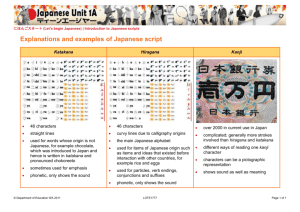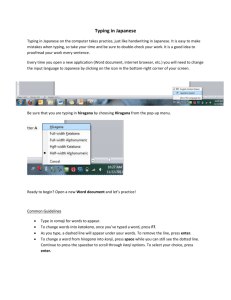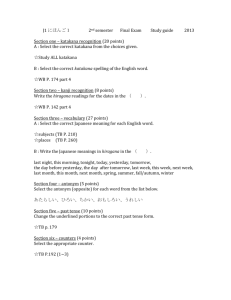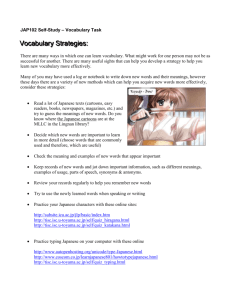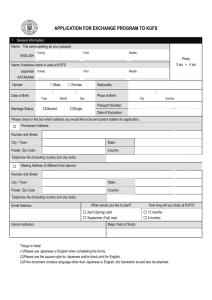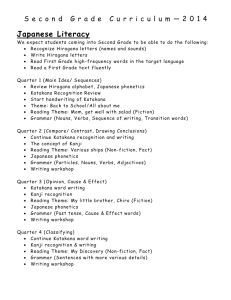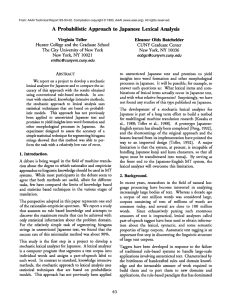The Japanese Language
advertisement
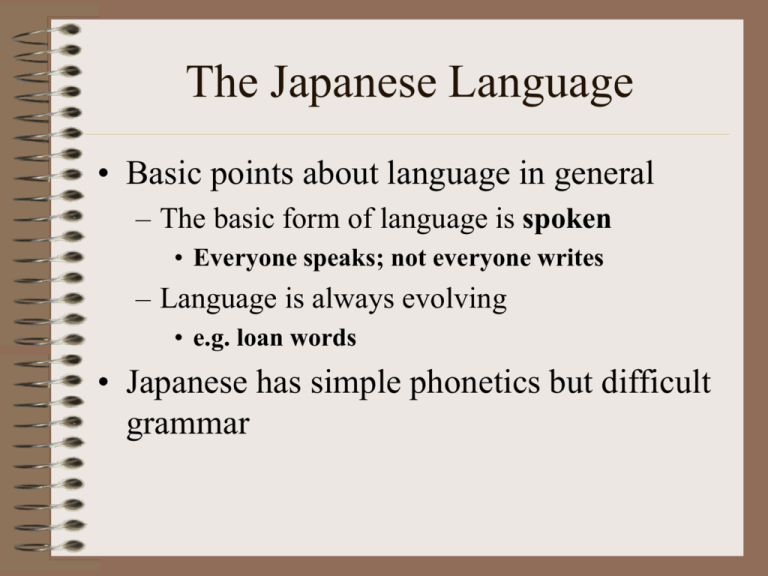
The Japanese Language • Basic points about language in general – The basic form of language is spoken • Everyone speaks; not everyone writes – Language is always evolving • e.g. loan words • Japanese has simple phonetics but difficult grammar Japanese phonetics • 5 vowels, all short –A I U E O • But Japanese sounds come in syllables – – – – – – ka ki ku ke ko also sa shi su se so ya ta chi tsu te to yu na ni nu ne no yo ha hi fu he ho wa ma mi mu me mo n ra ri ru re ro o More Japanese phonetics • 5 vowels, all short –A I U E O • Also vocalized variants – ga – za – Da gi ji ji gu zu zu ge ze de go zo do • And “ha” line has a “p” variant – pa pi pu pe po (etc.) Pronouncing loan words • All those vowels make words longer – McDonald’s becomes – Makudonarudo, that is, Ma-ku-do-na-ru-do • Confusion can ensue from lack of phonetic variation – A building is a birudingu, shortened to biru – Beer is called biiru – No L-R distinction; what to call Bill? Phonetics: lengthened vowels • the long marks over o and u • There’s a difference between – shinto (believer), and – Shintō (one of Japan’s religions) • The long marks mean that the sound of the vowel is lengthened (not changed) Basic Japanese grammar • The basic order of a Japanese sentence is subject⇨object⇨verb, as in – Kinō watashi wa hon o kaimashita. – (Yesterday I bought a book.) • If you leave out “watashi” (I), no one is confused. Subjects are often omitted. • Particles mark the function of a word – “wa” marks a subject, “o” an object Particles • There are particles for possession, location, etc. • The particle for possession is “no” – Kore wa watashi no hon desu. – Mitsubishi jidōsha no Tanaka desu. – possessive, or “of” Polite speech • Japan’s social hierarchy is reflected in speech patterns – How you speak depends on who you are talking to – Indicates both relative status and familiarity • Polite forms are typically longer and more complicated The writing system • Japanese has characters representing both sound and meaning • Sounds are written with the “kana” syllabaries (they represent syllables) – Hiragana – Katakana • Follow the A I U E O pattern Hiragana • Used mostly for word inflections – – – – – – – Japanese is an inflected language あ か さ た な は ま や ら い き し ち に ひ み り う く す つ ぬ ふ む ゆ る え け せ て ね へ め れ お こ そ と の ほ も よろ Also wa わ o を n ん • Hiragana is “loopy” looking Katakana • Used mostly for foreign words – – – – – – ア カ サ タ ナ ハ イ キ シ チ ニ ヒ ウ ク ス ツ ヌ フ エ ケ セ テ ネ ヘ オ コ ソ ト ノ ホ Also wa ワ o ヲ n ン マ ヤ ラ ミ リ ム ユ ル メ レ モ ヨ ロ • Katagana is “squarish” looking Writing other sounds • Changing “ha” to “ba” for example • は becomes ば • Paris パリ and Bali バリ • What about a word like Kyōto? – How do we write the “Kyō” sound – Kyōto is written きょうと Ideographs • Ideographic or pictographic characters – another borrowing from China – called kanji • By the end of High school, a person is supposed to know about 1,970 characters • Writing words in kanji saves confusion – Many homophones Kanji • Some Kanji are simple – Mountain is 山 (yama) – one (1) is 一; two is 二; three is 三 – but four is 四 – some are complicated! • hibiki 響 Twenty kanji for you • All from the “50 Chinese characters” in the reading • 一二三四五六七八九十 • 日月火水木金土山目人 • You will only be required to recognize them Summary • Japanese is phonetically simple – A I U E O and the other syllables • Sentence structure: – subject⇨object⇨verb – word functions marked by particles – kinō watashi wa hon o kaimashita • Three writing systems – hiragana, katakana, kanji; mixed together – 昨日私は本を買いました。
